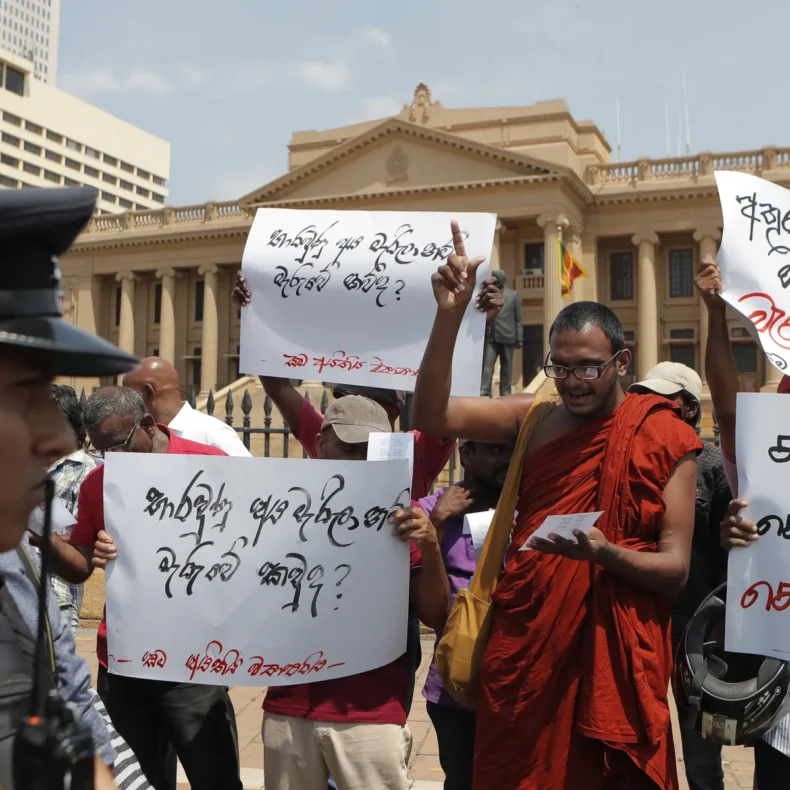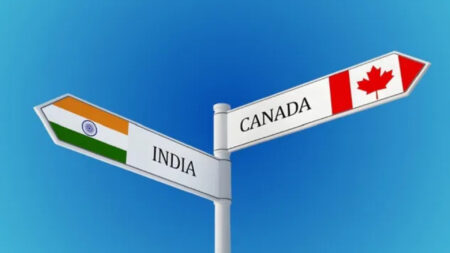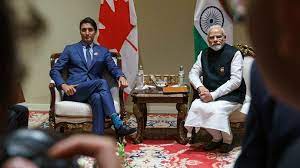“Look at you: Muslims, Hindus, and Catholics are all present. All of their blood is the same.” “This is the true Sri Lanka.”
Lukshan Wattuhewa gestures over Galle Face Green, Colombo’s colourful coastline, where tens of thousands of activists congregate every day.
He thinks that the country’s worst-ever economic crisis, which has fueled large anti-government rallies, would signal a turning point in the decades of ethnic and religious bloodshed that have damaged so many communities across Sri Lanka.
A Buddhist monk in the area concurs: “People are putting their differences of religion and race aside to join this fight. Sri Lanka has come together as one country.”
Both men are members of Sri Lanka’s Sinhala Buddhist majority, which makes up about three-quarters of the country’s varied population. The country’s minorities include Tamil Hindus, Muslims, and Christians.
“Gota go home.”
Citizens across Sri Lanka have been marching to the streets with a simple message: “Gota go home” for weeks.
“Gota” is the country’s president, Gotabaya Rajapaksa, who won an election on a Sinhala nationalist platform months after an Islamist organization carried out fatal Easter Day attacks in 2019.
His popularity has suddenly fallen. Many of those who voted for him have demanded his resignation due to economic difficulties. Apart from economic failure, charges of racism have dominated most of his reign.
Critics claim he used long-standing ethnic and religious divisions in the nation for political benefit. “I felt I could win this president by Sinhalese votes alone,” Mr Rajapaksa declared at his inauguration.
The Protests
During protests near the president’s office in Colombo, Sri Lanka, Sri Lankan catholic nuns cover protestors.
The Colombo protests have shown that people of all faiths and nationalities can come together.
Sinhalese dominance policies are not new in Sri Lanka, with Tamils traditionally the most targeted minority. When Sri Lanka’s government ended a decades-long civil conflict with the separatist LTTE (Tamil Tigers) in 2009, Gotabaya Rajapaksa was the country’s defence minister.
Many Sinhalese people lauded him as a hero at the time, but there have also been calls for him to be held responsible for human rights violations committed during the conflict.
Instead of reaching out to the Tamil minority, critics believe the Rajapaksas pursued a populist majoritarian agenda that treated Tamils as second-class citizens.
Violence
Muslims have become more demonized following the Easter Day attacks and Rajapaksa’s victory.
Shreen Saroor, a renowned Muslim rights activist, says, “We’ve seen mass-scale violence attacking Muslims’ dwellings, livelihoods, and our basic right to exist with dignity.”
Apart from mob violence and Sinhala Buddhist boycotts of Muslim companies, she claims the government’s general policy of forcefully cremating the dead – prohibited in Islam – “put bare ingrained anti-Muslim tendencies.”
For many supporters of the demonstrations, the inter-racial unity demonstrated at Galle Face Green in Colombo is a clear rebuttal of President Rajapaksa’s divisive policies. However, researchers caution that this is only one viewpoint.
“This is unquestionably a once-in-a-lifetime opportunity,” says Bhavani Fonseka, a senior researcher at Colombo’s Centre for Policy Alternatives.
“But it needs to be seen how this translates into meaningful development. Minorities are suspicious of the administration, especially because so many of those who used to support it are now protesting against it.”
On May 1, 2022, nonpartisan demonstrators organized a May Rally in Colombo, Sri Lanka, to protest the current economic crisis.
Protesters have demanded President Gotabaya Rajapaksa’s resignation.
While rallies in the cosmopolitan city are calm and carnival-like, the situation in the north and east of the nation, where most of Sri Lanka’s Tamil minority lives, is much different.
Even while anti-government sentiment has always been strong in these areas, protests have been unusual.
Tamil groups are concerned that security personnel may not use the same restraint shown to Colombo protesters.
“Organizing demonstrations have always been greeted with governmental brutality here,” says Anushani Alagarajah, a Tamil civil rights activist in Jaffna, Sri Lanka’s northwestern province. “Protesters are constantly subjected to two types of treatment. It varies according to who you are and where you are.
Rambukkana, a tiny rural village in central Sri Lanka, has been the site of the single protest-related death thus far.
Police fired live shots into a gathering, wounding 14 people and murdering a Sinhala Buddhist man.

Minorities
According to Alagarajah, a terrible incident might enlighten the country’s majority group, considering that minorities have endured crackdowns for decades.
However, she feels betrayed because, despite years of protests by her community, the Sinhala majority’s marches have gained international media attention.
Since the end of the civil war, many Tamils have gone missing or are unaccounted for. Still, successive Sri Lankan governments have sought to interfere with international efforts to investigate suspected war crimes.
Local officials have been jailed, including the Mayor of Jaffna last year, and memorial services for Tamil rebels are routinely prevented, frequently by force. There are also regular complaints of police abuse, although the north still has a significant security presence.
“Will we be able to feel secure in this protest space if we start talking about justice and accountability?” Alagarajah wonders.
She gives as an example the desecration of a Hindu shrine and temple in the country’s northeast, which was replaced with Buddhist emblems and flags.
Hindu worshippers who continued to visit the site were allegedly racially abused by monks and monitored by Sri Lankan intelligence personnel.
“You see Buddhist monks agitating for change in Colombo, yet just the other day in the north, monks prevented worshipers from entering a Hindu temple,” Alagarajah adds.
On April 30, 2022, Buddhist monks gather at Colombo’s Independence Memorial Hall to show sympathy with compatriots protesting the government over the country’s dire economic crisis.
Buddhist monks in Sri Lanka have expressed their support for the protests.
A line of monks is marching outside the Presidential Secretariat on Galle Face Green. In another display of interfaith unity, they are followed by a procession of Catholic nuns.
While moments like this are “wonderful to watch,” Amalini De Sayrah, one of several organizers in a mostly leaderless protest movement, believes there is much more work to be done, especially by her own Sinhala community.
“It’s wonderful that we were able to celebrate both the Sinhala and Tamil New Years at the same time. We’ve also held massive Iftars [fast-breaking meals] with Muslim demonstrators on this lawn.
“This would be the ideal time to achieve true, meaningful and long-lasting togetherness. I simply hope that in the post-Rajapaksa future that we all wish for, Tamils and Muslims are not consigned to the status of second-class citizens they have always been.”
According to Luckshan Wattuhewa, a protester on the beachfront, most individuals have the exact fundamental requirements right now: they are concerned with ensuring that their families have enough food, gasoline, and medication.
However, as a playwright, he wishes for a fresh chapter in the history of his country.
“We went through 30 years of war and a great deal of suffering. Enough is enough; we want a peaceful nation.”
Published by- NIKITA GOSWAMI













